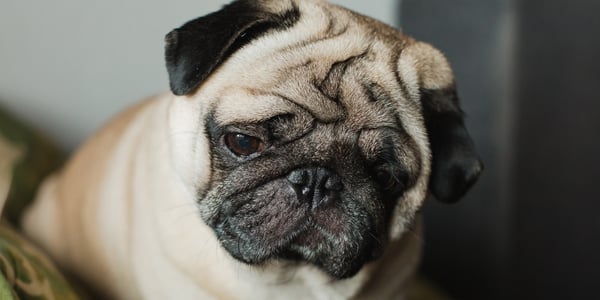Exploring Pug Colours & Waggel's Breed Coat Guide
Index:



Introduction
Your Pug’s coat may look simple—until you realise there are more shades of fawn than you ever imagined and don't get started on 'brindle stripes'.
You might be wondering if the breed standard includes your chocolate‑tinged pup?”
The good news? By understanding official guidance, common myths, and everyday care, you can relax and enjoy every wag of that curly tail, no matter the colour.
Key takeaways
The Pug dog breed has specific colours accepted by the British Kennel Club
The AKC recognises only fawn (all shades) and black.
Non‑standard coats like brindle or merle look striking but may hint at cross‑breeding and extra health concerns.
Bold markings such as the black mask and “trace” line are prized in fawn dogs.
Diets rich in omega oils keep every shade glossy; see our gut health guide for dogs.
Choose a reputable breeder who screens parents; avoid “rare colour” mark‑ups.
Waggel covers all coats equally—tail‑wagging peace of mind in one simple policy.
The official take on Pug colours
What the Kennel Club accepts
Britain’s Kennel Club lists four core coat colours: silver, apricot, fawn, and black, each with deep contrast between body colour and dark points (mask, ears, “thumb mark or diamond”, and tail trace).
Silver often looks pale dove‑grey; apricot glows warm peach, while classic fawn Pugs sit somewhere in between.
Judges want those points “as black as possible” to highlight the sweet muzzle wrinkles.
The American angle
Hop across the pond, and rules tighten. The American Kennel Club disqualifies any shade except fawn (which can vary from cream to rich apricot) or a true black Pug.
The aim is uniformity in the show ring, not to diminish your dog’s beauty at home.
If you fancy competing, stick to two colours; if you just want couch cuddles, variety is the spice of life.



Beyond fawn and black: Non‑standard coats explained
Apricot & silver fawn
Both are technically fawn derivatives. Apricot carries extra pheomelanin, giving a sun‑kissed look; silver fawn leans cool thanks to dilution genes.
Breeders note that lighter coats can show tear‑staining more easily, so keep wipes handy.
Brindle, merle and other show‑ring rebels
Brindle Pugs sport tiger stripes caused by a gene believed to come from French Bulldogs or Boston Terriers.
They’re not eligible for KC or AKC shows and may bring hidden ancestry
Merle is outright refused registration in the UK due to linked eye and ear defects.
A merle Pug at a dog show is like turning up to Wimbledon in neon Crocs—sure to cause a stir but unlikely to win medals.
Colour dilution and alopecia
Light cream, blue‑tinged or “isabella” coats in other toy breeds can suffer colour‑dilution alopecia—patchy baldness from fragile hairs.
While rare in Pugs, the underlying genetics overlap, reminding us that fashionable shades can come with baggage.
Coat, markings and show status



Why colour links to health & welfare
Genes controlling Pug coat shade also influence pigment in eyes, ears and skin. Studies show mutations reducing pigment can raise deafness or vision risks.
Meanwhile, the breed’s signature flat face—colour aside—predisposes to airway struggle, overheating, and dental crowding.
Black markings signal higher eumelanin, which research suggests is linked to stronger hair shafts.
Black Pugs should be walked much less than other colourings as they can overheat more quickly.
Everyday coat care for every colour
Brush weekly with a soft mitt to lift shed hair.
Wipe facial folds daily to dodge infection—more visible on pale dogs.
Bathe monthly using pH-balanced shampoo; rinse thoroughly to avoid residue on wrinkled muzzle skin.
Feed high‑quality protein and fish oil to help their coat shine.
Pop on UV‑blocking dog shirts during summer if your vet recommends it
Short sessions, especially when bathing, keep tasks fun; if your puppy thinks the bath is a paddling pool, you’re already winning.



Grooming, diet and shedding
Pugs shed more than you’d expect from a compact dog breed. Their light hairs will show up on darker clothes, while black fluff clings to cream sofas like it's magnetic—proof that their shedding is colour‑blind.
Regular deshedding reduces airborne fur and dander. That's why we recommend regular brushing sessions with a mitt.
Picking the right breeder
Fancy a Pug for your household? Well, firstly, make sure you ask any breeder for:
KC registration papers
DNA tests for PDE and PK deficiency
Vet certificates for nostril and airway grading
View of mum and litter in the home
If the seller pushes colour over welfare, walk away. Pedigree matters more than Pantone.



Ready to protect every shade?
Whichever colour or pattern your individual Pug wears—classic fawn or rebellious brindle—intentional care and solid insurance keep tails wagging. Get a flexible policy today in under three minutes by visiting our quote page, and let us handle life’s unexpected vet bills while you handle belly rubs.
Waggel Pet Insurance
Need more help? You're in luck if you're a Waggel Pet Insurance member. Along with our excellent coverage, we offer access to a 24/7 online vet to answer all your sticky questions, especially if you need grooming assistance.
Not a member? Why not get a quote now and cover your furry friend for a range of illnesses, all while enjoying our amazing perks and rewards.
Want more like this?
Get updates from us with helpful info, advice, answers to frequently asked questions and much more.
Index:
Related posts:
Get your quote
Along with our excellent coverage, we offer access to a 24/7 online vet to answer all your sticky questions.





